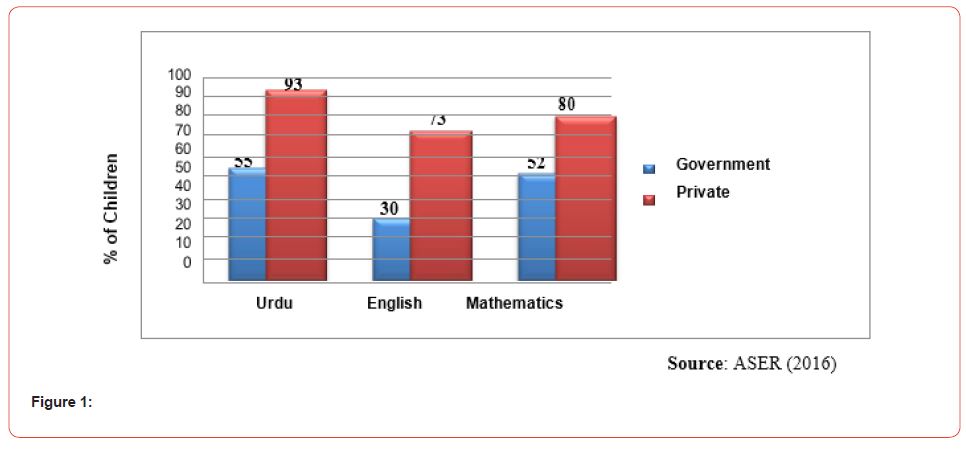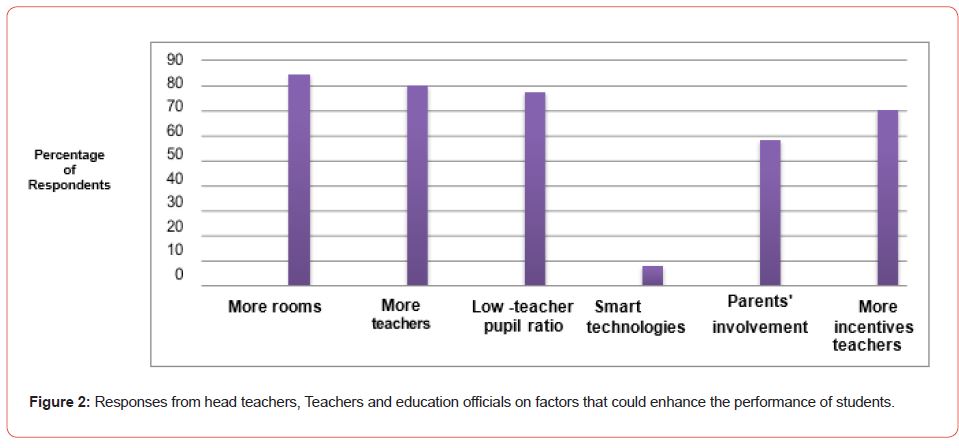Authored by Yidersal Erega*,
Abstract
The present study was conducted to assess seed rate (SR) and nitrogen rate (NR) effects on biomass yield and nutritional quality of oat (Avena sativa L.) at Sirinka, North Eastern Amhara, Ethiopia on July 2018. Levels of SR were 60, 80 and 100 kg/h and that of NL were 50, 100 and 150 kg/ha in the form of Urea (46% N). The experiment was conducted in a 3x3 factorial arrangement of treatments in a Randomized Complete Block Design (RCBD) with 3 replications giving a total of 27 plots, each measuring 2×1.4 m2. Growth and yield parameters were analyzed. Results showed that the interaction between seed rate and nitrogen rate had a significant (p<0.05) effect on almost all parameters measured except tiller number per plant (TNP). Green forage yield and dry matter yield increased with increasing level of seed rate and level of nitrogen. Generally, combination of 100 kg/ ha seed rate and 150 kg/ha nitrogen recorded higher forage yield. Thus, seed rate of 100 kg/ha and nitrogen fertilizer rate of 150 kg/ha Urea can be recommended for use by farmers in Sirinka area and other areas having similar agro-ecologies and soil type.
Keywords: Biomass yield; Nitrogen rate; Nutritive value; Oat; Seed rate
Introduction
Ethiopia is believed to have the largest livestock population in Africa [1]. Livestock sector has been contributing considerable portion to the economy of the country, and still promising to rally round the economic development of the country [2]. It is eminent that livestock products and by-products in the form of meat, milk, honey, eggs, cheese, butter and provide the needed animal protein that contribute to the improvement of the nutritional status of the people, as well supporting and sustaining the livelihoods of an estimated 80% of the rural population [1,2]. Livestock is an integral part of the farming systems and source of many social and economic values such as food, draught power, fuel, cash income, security and investment in both the highlands and the lowlands/pastoral farming systems [3,4]. The contribution of livestock to the national economy is estimated to be 30% of the agricultural GDP and 19% of the export earnings [2,3]. In spite of the immense contribution of the livestock sector to the national economy, animal productivity is extremely low mainly due to poor standard of feeding both in terms of quality and quantity as the production performance of an animal often reflects its nutritional status [4].
In most tropical countries, inadequate supply of feed is the bottleneck to livestock production [2]. This is due to the dependence of livestock on naturally available feed resources and little development of forage crops for feeding animals [5]. Like in other tropical countries, in Ethiopia, most of the areas in the highlands of the country are nowadays put under cultivation of cash and food crops which resulted in keeping large number of livestock on limited grazing areas leading to overgrazing and poor productivity of livestock [4]. Though, expansion in the cultivation of cereal crops increased the supply of crop residues for animal feeding but, crop residues have low nutritive value and could not support reasonable animal productivity [5]. Hence, shortage of nutrients for livestock is increasingly becoming serious issue in Ethiopia. One of the alternatives to improve livestock feeding, and thereby enhance productivity of livestock is through the cultivation of improved forages and offer them to animals during critical periods in their production cycle and when other sources of feeds are in short supply [2]. The use of cultivated forage crops has received considerable attention for complementing the conventional feed resources especially in areas where feed shortage is the main constraint for livestock productivity [2,5]. From the forage crops, due to short life cycle, suitability in crop rotations and better performance on marginal lands, oat (Avena sativa L.) is an important species for integration into the existing farming system [6]. Oats can be easily cultivated, develops rapidly, and yields high amounts of dry matter and green forage of higher quality when managed properly. Oats are forage crop grown at medium to high altitudes (1600-3000m) on heavy soils (vertisols) where temperate grasses and other improved forages are difficult to establish [2]. The species owes its reputation to its versatility as it can be grown for grain, hay, silage or direct grazing and is being used as feed for dairy cattle, young stock, sheep and goats [7]. Moreover, it has superior recovery after grazing and is highly useful for overcoming critical periods of feed shortage or for finishing animals for market when permanent pastures are of poor quality [8].
With other factors, seed rate, and level of nitrogen fertilizer are key factors, which contribute to the yield and quality of oat [8]. These conditions vary greatly across the agro-ecological areas [5]. Higher fodder yield with fertilizer application is due to their favorable effects on plant water relations, light absorption, crop density, plant height, leaf area and nutrient utilizations [9]. The applications of nitrogen fertilizer improve the dry matter, biomass yield and quality of forage [5]. Hence, there is a need to determine an appropriate level of fertilizer application especially in soils deficient in nitrogen and proper seeding rate to positively affect oat production both in terms of yield and quality. Therefore, to utilize oat as a potential fodder crop in the study area, appropriate seeding rate and level of nitrogen fertilization needs to be determined. Such information appears to be lacking in the study area, and such information are location specific based on the soil fertility status of an area. Hence, this experiment was conducted with the following objectives:
Objective
• To investigate the effect of seed rate and nitrogen rate on growth and biomass yield of oat (Avena sativa L.) at Sirinka, North Eastern Amhara, Ethiopia.
Materials and Methods
Description of the study area
The study was conducted at Sirinka Agricultural Research Center (SARC), which is located 508 km North of Addis Ababa, the capital of Ethiopia (Figure 1). The site is located at an altitude of 1850 meters above sea level and at 110°451’0011” North latitude and 390°361’3611” East longitude [10]. The rainfall pattern is bimodal, with two-rainfall seasons, ‘belg’ (February/March - April) and ‘Meher’ (July-September) with a mean annual rainfall of 950mm. The mean daily temperature range is of 16-21 °C [11]. The soil type of the experimental fields is clay loam, with a pH of 6.98. The soil, organic carbon is 1.35%, total N was 0.07%, available P 13.7 mg kg-1 [1,12].
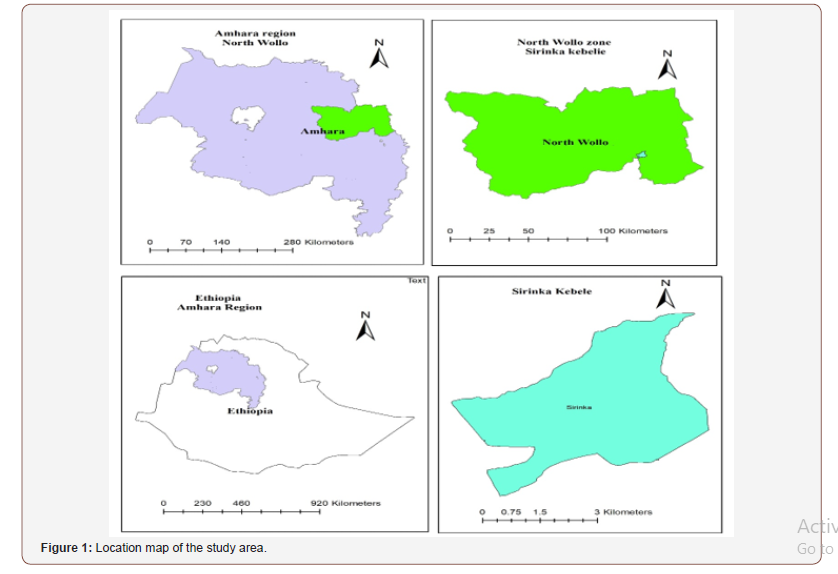
Experimental materials
The materials used in this experiment was Lampton oat variety, which was recommended by Sirinka Agricultural Research Center as a suitable variety for North Eastern Amhara locality. Nitrogen fertilizer was used as other experimental material in the form of fertilizer grade Urea (46% nitrogen).
Experimental design, treatments and procedures
The study was a 3 x 3 factorial arrangement of treatments in a randomized complete block design (RCBD). The two factors were seed rate with three levels (60, 80 and 100 kg/ha) and nitrogen fertilization with three levels (50, 100 and 150 kg/ha) (Table 1). The seed rate and nitrogen fertilization rates were the recommendations set by Sirinka Agricultural Research Center for the oat variety. The gross size of the experimental plot was 2m x 1.4m length and width respectively, accommodating 7 rows of oats at a spacing of 20 cm between rows. Space of net sampling plot size was 1.8m x 1m length and width respectively, in which the two outer most rows and 0.1 m length at both ends considered as border leaving. Five middle rows were used as sampling rows.
Table 1: Treatment combinations used in the experiment.
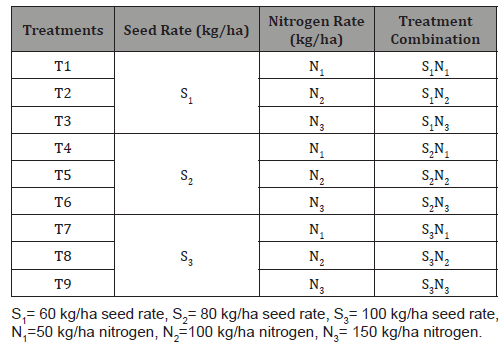
Land was prepared using tractor drawn cultivator once and bullock twice. The smoothened land was laid out according to the experimental plan. The oat was planted at middle of July 2018 cropping season with 20 cm between rows with three levels of seed rate. The forage was supplied with three levels of nitrogen, in the form of urea. Nitrogen was applied as per treatment specifications. Half dose of the nitrogen was applied at the time of sowing in band in small furrows opened manually adjacent to the seed line and covered with soil to avoid the losses and the remaining 50 percent nitrogen was applied at tillering stage. Full dose of NPS fertilizer (121 kg/ha) was applied at sowing time for all of the plots as a common treatment. All other necessary field management practices were carried out equally for all experimental units.
Data collection
Growth parametersa. Plant height (cm): The height of ten main shoots from sampling units were measured in cm and averaged. The height measurement was taken from ground level to the base of the fully opened youngest leaf before heading and to the tip of panicle after heading.
b. Number of tillers (per m row length): Total number of shoots (tillers) from demarcated one-meter row length were counted and expressed as average shoot number per meter row length.
c. Number of tillers per plant: Total number of shoots (tillers) from demarcated ten sampling units were counted and expressed as average tiller number per plant from net plot area.
d. Fresh weight per tiller: The total fresh weight of demarcated ten sampling units were divided by respective tiller numbers to record fresh weight per tiller in grams.
Yield parameters
a. Biomass yield (t/ha): The green fodder from the net plot area were harvested leaving 10 cm from the ground level at 50% flowering/heading stage. After harvesting, the produce was weighed in kg from individual plots and was converted and expressed as green forage yield (GFY) in tons per hectare (t/ha).
b. Dry matter yield (t/ha): The dry matter yield (DMY) was determined after dying the fresh samples in an oven at 70 0C for 48 hours. The plot-wise green forage yield was multiplied by respective dry matter percentage to get dry weight in kg per plot and was expressed in t/ha.
Data analysis
The collected data was subjected to the analysis of variance (ANOVA) using the SAS computer package version 9.1 [13]. Mean separation was carried out using least significance difference (LSD). The model for data analysis consists the effects of seeding rate, nitrogen fertilization rate and their interaction. When interaction was significant (P<0.05) simple effect means were compared, otherwise main effect means were compared.
The statistical model used was: Yijk = μ + Si + Nj + Bk + SNij + εijkl;
Where,
Yijk = measurable variable,
μ = overall mean,
Si = the ith seeding rate effect,
Nj= the jth nitrogen fertilization rate effect,
Bk = kth Block effect,
SNij = interaction of seed rate and nitrogen fertilization rate and
εijkl = random error term.
Results
Plant height and tiller number per plant
Plant height was significantly affected (p<0.001) by the interaction of seed rate and nitrogen rate (Table 2). The application of 100 kg/ha seed rate with 150 kg/ha nitrogen and 80 kg/ha seed rate with 150 kg/ha nitrogen resulted to significantly higher plant height as compared to other combination of treatments. This was followed by the treatment containing 80 kg/ha seed rate with 100 kg/ha nitrogen, and the lowest plant height was recoded for 60 kg/ha seed rate with 50 kg/ha nitrogen treatment. Although there was significant interaction between seed rate and nitrogen rate on plant height, the trend of response to nitrogen fertilization was consistent as each level of seed rate and vice versa. Plant height was highest for 100 kg/ha seed rate followed by 80 kg/ha and was lowest for the 60 kg/ha seed rate (p<0.01). There was no significant effect of seed rates, nitrogen fertilization rate and their interaction on number of tillers per plant (Table 2). Average number of tillers per plant were 7.64, 5.95 and 5.87 for 80, 60 and 100 kg/ha seed rates, respectively. The number of tillers per plant were 7.75, 5.95 and 5.75 for 150, 100 and 50 kg/ha, respectively.
Table 2: Growth and yield parameters of oat as affected by seed rate and different levels of nitrogen.
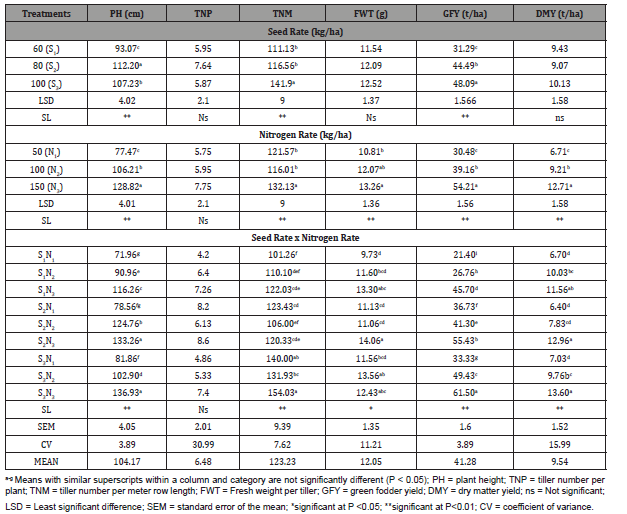
Tillers number per meter row length
Number of tillers per meter row length was significantly affected (p<0.01) by seed rate, nitrogen rate and interaction of seed rate and nitrogen rate (Table 2). Interaction effect of seed rate and nitrogen effect was also significant (p<0.001) for this parameter with seed rate of 100 kg/ha seed rate with 150 kg/ha nitrogen recorded higher tillers per meter row length. Number of tillers per meter row length appears to increase with increase in seed rate. The seed rate of 100 kg/ha recorded significantly a greater number of tillers per meter row length (p<0.01) as compared to the other seed rates, while values for the 60 and 80 kg/ha seed rates were similar.
Fresh weight per tiller
The interaction effect of seed rate and nitrogen rate on fresh weight per tiller was significance (p<0.05) and statistically the maximum fresh weight per tiller was recorded in 80 kg/ha seed rate and 150 kg/ha nitrogen rate, and in 100 kg/ha seed rate and 150 kg/ha nitrogen rate. The minimum fresh weight per tiller was recorded in 60 kg/h seed rate and 50 kg/h nitrogen fertilizer. The increase in fresh weight per tiller in the treatments was probably due to higher number of leaves per plant, plant height and leaf area per plant associated with the particular treatment combinations of seed rate and nitrogen rate. Seed rates has no significant effects on fresh weight per tiller and was 12.52, 12.09 and 11.54 g for 100, 80 and 60 kg/ha seed rate, respectively.
Green forage yield
The nitrogen × seed rate interaction for forage green yield was significant (p<0.01) (Table 2). The treatment combination with the highest level of seed rate and nitrogen resulted to the highest green forage yield. This was followed by 80 kg/ha seed rate and 150 kg/ ha nitrogen rate. Conversely, the lowest value of green forage yield was noted for 60 kg/ha seed rate and 50 kg/ha nitrogen rate. Green forage yield of oat increased with increase in seed rate from 60 to 100 kg/ha (p<0.001). Green forage yield of oat also increased significantly (p<0.001) with increase in nitrogen rate from 50 to 150 kg/ha
Dry matter yield
Dry matter yield of oat differed significantly (p<0.001) due to levels of nitrogen and their interaction with seed rate but seed rate has no significant effect on dry matter yield of oats (Table 2). The treatment combination 100 kg ha-1 seed rate at 150 kg ha-1 nitrogen recorded significantly higher total dry matter yield (13.60 t ha-1) followed by 80 kg ha-1 seed rate at 150 kg ha-1 nitrogen (12.96 t ha-1) which was statistically the same with the previous treatment combinations. However, the significantly lowest dry matter yield was recorded with 60 kg ha-1 seed rate at 50 kg ha-1 nitrogen (6.70 t ha-1) which were par with dry matter yields 6.40 t ha-1 and 7.83 t ha-1 recorded at treatment combinations S2N1 i.e. 80 kg ha-1 seed rate at 50 kg ha-1 nitrogen and S2N2 i.e. 80 kg ha-1 seed rate at 100 kg ha-1 nitrogen, respectively.
Discussion
Plant height
Plant height was significantly affected (p<0.001) by the interaction of seed rate and nitrogen rate (Table 2). The application of 100 kg/ha seed rate with 150 kg/ha nitrogen and 80 kg/ha seed rate with 150 kg/ha nitrogen resulted to significantly higher plant height as compared to other combination of treatments. This was followed by the treatment containing 80 kg/ha seed rate with 100 kg/ha nitrogen, and the lowest plant height was recoded for 60 kg/ha seed rate with 50 kg/ha nitrogen treatment. Although there was significant interaction between seed rate and nitrogen rate on plant height, the trend of response to nitrogen fertilization was consistent as each level of seed rate and vice versa. Plant height was highest for 100 kg/ha seed rate followed by 80 kg/ha and was lowest for the 60 kg/ha seed rate (p<0.01). This increase in plant height with seed rate may be due to the fact that dense plants compete for light and nutrients that negatively impact the growth rate. Similarly, Sadig et al. [14]; Dawit & Teklu [5] indicated that plant height increased with increasing seeding rate. However, the current result disagrees with the result of Ayub et al. [15] and Iqbal et al. [16], who reports that plant height of fodder maize was not significantly affected by seed rate. The nitrogen rates influenced plant height significantly (p<0.001) and plant height increased with increase in nitrogen rates (Table 2). Plant height was most responsive to nitrogen application and each successive increase in nitrogen dose significantly produced taller plants. These finding is in line with the results of Zada et al. [17] and Iqbal et al. [16] who reported that plant height increases with the increase in nitrogen doses. Increase in plant height of oat with nitrogen application has also been reported by Sharar et al. [18] and Ayub et al. [15].
Tiller number per plant
There was no significant effect of seed rates, nitrogen fertilization rate and their interaction on number of tillers per plant (Table 2). Average number of tillers per plant were 7.64, 5.95 and 5.87 for 80, 60 and 100 kg/ha seed rates, respectively. The result was in agreement with the work of Murtada [19] who reported that seeding rates had no significant effect on number of tillers per plant. The number of tillers per plant were 7.75, 5.95 and 5.75 for 150, 100 and 50 kg/ha, respectively. Plant population and number of tillers is always a function of germination percentage. The nonsignificant effect of nitrogen on number of tillers may be attributed to the fact that nitrogen might have no effect on germination, therefore plant density under different level of nitrogen can be stable. Similarly, Murtada [19] and Johnston et al. [20] reported that nitrogen rates did not affect number of tillers per plant of maize. But the results of Iqbal et al. [16], who noted increase in nitrogen rates increased the number of tillers per plant in oats disagrees with the current finding.
Number of tillers per meter row length
Number of tillers per meter row length was significantly affected (p<0.01) by seed rate, nitrogen rate and interaction of seed rate and nitrogen rate (Table 2). Interaction effect of seed rate and nitrogen effect was also significant (p<0.001) for this parameter with seed rate of 100 kg/ha seed rate with 150 kg/ha nitrogen recorded higher tillers per meter row length. Number of tillers per meter row length appears to increase with increase in seed rate. The seed rate of 100 kg/ha recorded significantly a greater number of tillers per meter row length (p<0.01) as compared to the other seed rates, while values for the 60 and 80 kg/ha seed rates were similar. High tillers per meter row length with the highest seed rate may be due to plant density produced at higher seed rate. The result was in agreement with the finding of Jayanthi et al. [21] and Aravind [9] who reported that seed rate of 125 kg/ha recorded significantly a greater number of tillers per meter row length of oat than lower levels of seed rates. Nitrogen rate significantly (p<0.001) influenced the number of tillers per meter row length (Table 2). Nitrogen rate of 150 kg per ha recorded significantly higher number of tillers per meter row length than other nitrogen rates, while values for the 100 and 50 kg/ha nitrogen rates were similar (p>0.05). Similarly, Jayanthi et al. [21], revealed that the application of organic and inorganic nitrogen fertilizers recorded higher number of tillers per meter row length in oat.
Fresh weight per tiller
The interaction effect of seed rate and nitrogen rate on fresh weight per tiller was significance (p<0.05) and statistically the maximum fresh weight per tiller was recorded in 80 kg/ha seed rate and 150 kg/ha nitrogen rate, and in 100 kg/ha seed rate and 150 kg/ha nitrogen rate. The minimum fresh weight per tiller was recorded in 60 kg/h seed rate and 50 kg/h nitrogen fertilizer. The increase in fresh weight per tiller in the treatments was probably due to higher number of leaves per plant, plant height and leaf area per plant associated with the particular treatment combinations of seed rate and nitrogen rate. Seed rates has no significant effects on fresh weight per tiller and was 12.52, 12.09 and 11.54 g for 100, 80 and 60 kg/ha seed rate, respectively. These results were in contrast with the findings of Oad et al. [22] who found that fresh weight per tiller of oat was affected significantly by using varying rates of seed. Fresh weight per tiller was affected significantly (p<0.001) by the application of different levels of nitrogen fertilizers. Fresh weight per tiller was higher for 150 kg/ha than 50 kg/ha nitrogen rate, while the value for 100 kg/ha was similar with the other two nitrogen rates. The trend in increased the fresh weight per tiller with increasing nitrogen rate may be attributed to the fact that nitrogen increase plant growth and consequently heavier tillers. This result is in line with that reported by Gasim [23] and Johnston et al. [20] who noted that increasing the level of nitrogen increased fresh weight per tiller oat. Significant variations among oat varieties due to nitrogen rate differences for fresh weight per tiller have also been reported by Arif et al. [24] and Naeem et al. [25]. The increase in fresh weight per tiller in the treatments was probably due to higher number of leaves per plant, plant height and leaf area per plant associated with the particular treatment combinations of seed rate and nitrogen rate.
Green fodder yield
The nitrogen × seed rate interaction for forage fresh yield was significant (p<0.01) (Table 2). The treatment combination with the highest level of seed rate and nitrogen resulted to the highest fresh forage yield. This was followed by 80 kg/ha seed rate and 150 kg/ ha nitrogen rate. Conversely, the lowest value of green forage yield was noted for 60 kg/ha seed rate and 50 kg/ha nitrogen rate. Green forage yield of oat increased with increase in seed rate from 60 to 100 kg/ha (p<0.001). This may be due to the fact that high seed rate resulted in high plant density. This result indicated a close relationship between forage yield and seed rate or plant density. Similar results on oat were reported by Yilmaz et al. [26], Iqbal et al. [16] and Budakli et al. [27]. Green forage yield of oat also increased significantly (p<0.001) with increase in nitrogen rate from 50 to 150 kg/ha. Application of nitrogen fertilizer, therefore, provided better nutrient to oat which resulted in higher fodder yield. Increase in fodder production with the application of nitrogen may be due to the better growth of plants as expressed in terms of plant height, number of tillers, fresh and dry weight of fodder, which was favorably affected by nitrogen fertilizer. Similarly, the increasing trend of green forage yield of oat in response to increasing level of nitrogen fertilizer was observed by many other workers [5,28]. The beneficial effect of nitrogen on forage yield of oat has also been reported by Thakuria & Gagoi [29] and Sheoran et al. [30]. But Iqbal et al. [16] and Sadig et al. [14] noted that further increase in nitrogen (158 kg/ha) showed a negative effect on fodder yield of oat, but also increased economics of fertilizer. This might be due to the fact that excessive fertilization caused lodging, which could reduce biomass yield.
Dry matter yield
Dry matter yield of oat differed significantly (p<0.001) due to levels of nitrogen and their interaction with seed rate but seed rate has no significant effect on dry matter yield of oats (Table 2). The treatment combination 100 kg ha-1 seed rate at 150 kg ha-1 nitrogen recorded significantly higher total dry matter yield (13.60 t ha-1) followed by 80 kg ha-1 seed rate at 150 kg ha-1 nitrogen (12.96 t ha-1) which was statistically the same with the previous treatment combinations. However, the significantly lowest dry matter yield was recorded with 60 kg ha-1 seed rate at 50 kg ha-1 nitrogen (6.70 t ha-1) which were par with dry matter yields 6.40 t ha-1 and 7.83 t ha-1 recorded at treatment combinations S2N1 i.e. 80 kg ha-1 seed rate at 50 kg ha-1 nitrogen and S2N2 i.e. 80 kg ha-1 seed rate at 100 kg ha-1 nitrogen, respectively. Contrary to the current result, Iqbal et al. [16] reported that dry matter yield of maize was affected significantly by different seed rates. This disagreement may be due to differences in seeding rates used, since seed rates used by other scholars had higher variation than the current study. Total dry matter yield of oat increased significantly with increase in nitrogen rate from 50 to 150 kg/ha. These fertilizers promote vigorous plant growth and a larger leaf area that contribute to the dry matter yield of the fodder oat. Iqbal et al. [16] and Dawit & Teklu [5] reported the same result, DM yield of fodder oat increased with increasing level of fertilizer [31].
Conclusion
From this result it can be concluded that:
• High seed rate had more plant population and consequently increased tiller number per meter row length and green fodder yield.
• Increased nitrogen rate increased number of leaves and promotes good plant growth, which leads to higher biomass production with improved forage quality (protein).
• Increase in nitrogen fertilization with increase in seed rate gives higher green forage yield and higher dry matter yield.
Based on the above result the following recommendations were forwarded.
• For better biomass yield with improved dry matter yield, S3N3 i.e., 100 kg/ha seed rate at 150 kg/ha nitrogen can be recommended for use by farmers in Sirinka area and other areas having similar agro-ecologies and soil type.
• Further assessment of the oats production for its performance over years, across diverse agro-ecologies and on-farm farmer managed plots is also vital to more fine-tuned recommendation.
To read more about this article...Open access Journal of of Agriculture and Soil Science
Please follow the URL to access more information about this article
To know more about our Journals...Iris Publishers
To read more about this article...Open access Journal of of Agriculture and Soil Science
Please follow the URL to access more information about this article
To know about Open Access Publishers


